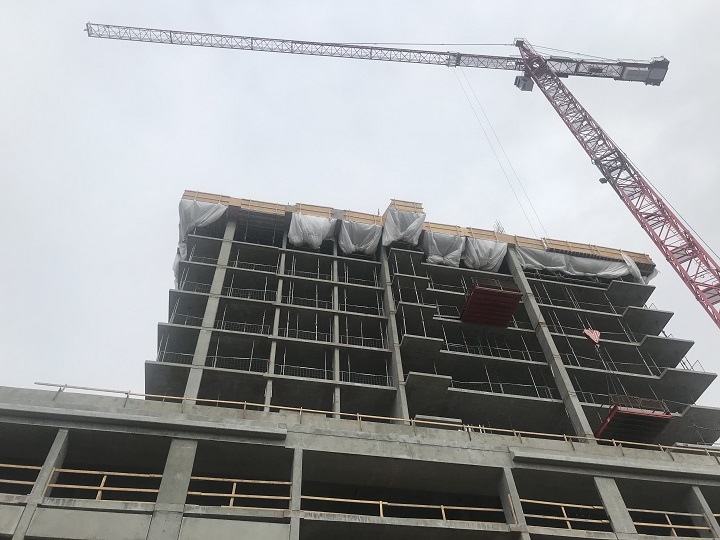An annual report by the Chartered Professional Accounts of B.C. says the Thompson-Okanagan region has eclipsed 600,000 residents.

The report, titled B.C. Check-Up: Live, was issued Tuesday and focuses on demographic and affordability trends across the province.
According to the report, the Thompson-Okanagan region added 8,462 new residents in 2020, bringing the total population to 609,320 residents.
“While population growth slowed in 2020 due to a decline in international immigration, the moderation was not as hard felt by our region as compared to other parts of the province,” said Karen Christiansen, a partner at an accounting and business consulting firm in Kelowna.
“Further, the Thompson-Okanagan has seen the fastest population growth in B.C. over the past five years, as many from across the province and outside the province relocated to the region.”
The report says between 2016 and 2020, the region’s population increased by 7.1 per cent as a result of a growing number of residents coming from other parts of Canada.

Further, of those 8,000-plus residents who moved to the Thompson-Okanagan, the report said the majority were 25 to 54 years old.
“This is critical as natural growth is trending downward as our population continues to age,” said Christiansen.
“In fact, Kelowna has the second-lowest fertility rate in Canada, just behind Victoria. However, inadequate housing supply and rising prices have become a growing challenge.”
The report noted that during the past five years, the number of residents increased by 53,113, but that only 19,746 residential housing units were built.
It added that in 2020, 4,134 housing units were built – down from 5,676 in 2019 but still above the average of 2,525 from 2011-18.

Christiansen called it encouraging to see housing construction pick up, but said it’s not keeping pace with population growth.

Get breaking National news
She also said in 2020, 70 per cent of the units completed were attached compared to 43 per cent in 2016.
“This demand-supply mismatch is pushing housing prices up across the region, especially for larger homes,” she said.
Across the Okanagan Valley, the average single-family home sold for $756,200 in April 2021, up by nearly a third (29.4 per cent) compared to April 2020. The average price for an apartment sold in April 2021 was $407,000, up by 12.6 per cent over April 2020.
“Housing prices have been rising rapidly due to the low-interest-rate environment, strong demand for more space, and lack of supply,” said Christiansen.
“The region needs to attract residents, especially young families who are being priced out of homeownership in the Lower Mainland. Going forward, it will be critical to encourage greater housing developments to help improve accessibility and affordability for both local and future residents.”

Elsewhere throughout the province:
Lower Mainland
The Southwest area of B.C. area grew by 34,823 residents in 2020, pushing that region’s population total to 3.15 million.
Despite that gain, though, it was 20,000 less than the record-setting 54,813 who moved there in 2019.
More than half of the people who moved there last year were between 25 and 54 years old.
The region’s average age increased from 40.7 in 2016 to 41.3 in 2020, slightly below the provincial average of 42.6.
The proportion of those aged 55 and older was nearly a third of the population (30.2 per cent) in 2020, up by 1.7 percentage points from 2016.
In April 2021, the average price of a single-family home across the Lower Mainland reached $1.57 million, up by nearly a quarter (24.9 per cent) compared to April 2020.
The average price for an apartment reached $694,200, a gain of 6.6 per cent over April 2020.

Greater Victoria
The Greater Victoria area grew by 5,651 residents in 2020, pushing that region’s population total to 425,503.
There was no information on the average age in Greater Victoria.
The average house in Greater Victoria in May 2021 was $923,000, up by 19.3 per cent from May 2020. The average price of an apartment was $513,400, up seven per cent from one year ago.
Vancouver Island
The Vancouver Island area, excluding the Capital District, grew by 4,747 residents in 2020, pushing that region’s population total to 456,182.
The average age on Vancouver Island in 2020 was 45.7 years old, the oldest in the province.
Across Vancouver Island, the average home sold for $661,100 in April 2021, up 22.2 per cent from April 2020. The average price for an apartment sold in April 2021 was $343,800, up by 13.6 per cent over April 2020.

Kootenays
The Kootenays grew by 1,200 residents in 2020, pushing that region’s population total to 163,123.
Most people who moved to the Kootenays were 39 years old and younger.
The average age in the Kootenays in 2020 was 45.3, above the provincial average of 42.6, and up from 44.7 in 2016.
The average house in the Kootenays in May 2021 was $458,121, up by 24.4 per cent from May 2020.
Northwest B.C.
The Northwest grew by 721 residents in 2020, pushing that region’s population total to 99,758.
- Carney, Trump and Sheinbaum talk trade in Washington at FIFA World Cup draw
- Health Canada recalls glucose monitors that may give ‘incorrect’ readings
- Newfoundland girl’s disappearance prompts calls for tougher laws to stop abductions
- Industry experts question Saab’s pitch to bring 10,000 jobs to Canada
The average age in the Northwest in 2020 was 40.5, up 0.8 years from 2016.
The average house in the Northwest varied from community to community, but ranged between $290,000 and $377,000.
Northeast B.C.
The Northeast grew by 88 residents in 2020, pushing that region’s population total to 72,280.
The average age in the Northeast in 2020 was 36.6, six years below the provincial average of 42.6.
The average house in the Northeast varied from community to community, but the average price in the South Peace River area in May 2021 was $272,053.
For more about the report, visit this website.









Comments